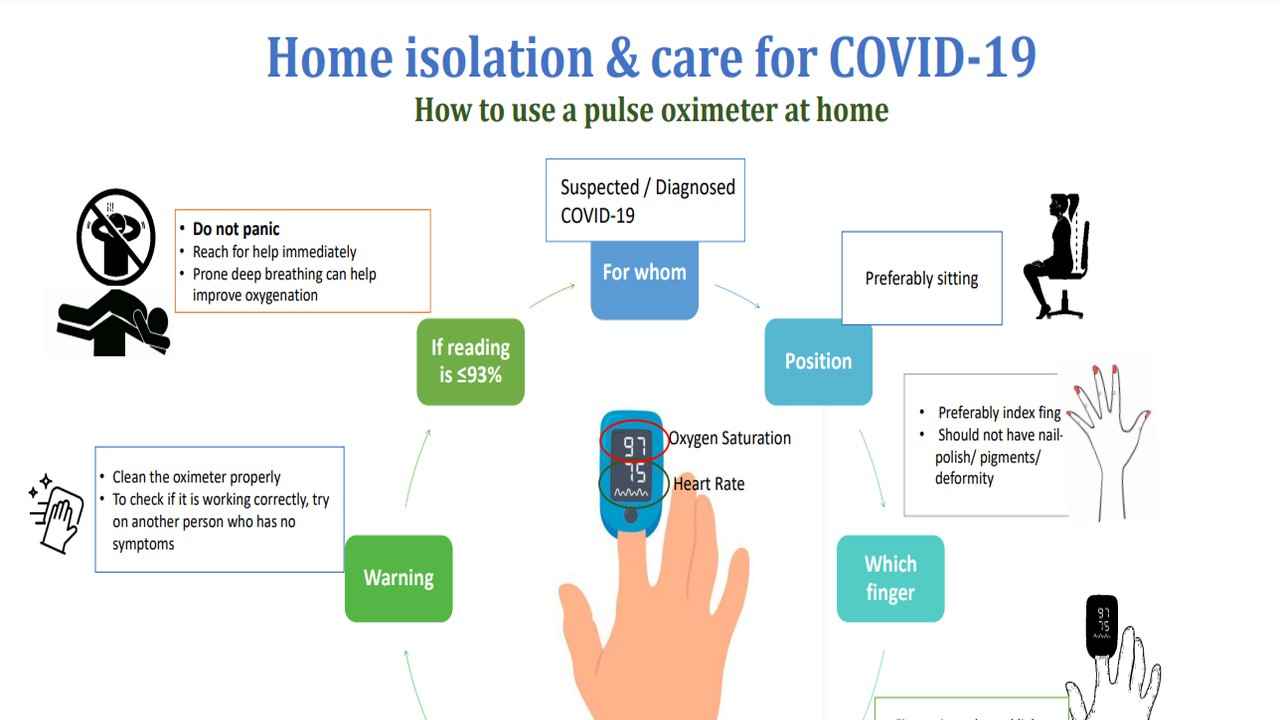COVID-19: How to use pulse oximeter at home to get accurate blood oxygen saturation readings
A pulse oximeter helps in monitoring your pulse and blood oxygen levels.
How to use oximeter at home to get accurate blood oxygen readings.
How to use oximeter at home to get accurate blood oxygen readings.

The number of COVID 19 cases are increasing globally as well as in India. In case you or a family member is infected with the virus, one of the most important things is monitoring oxygen levels regularly. You should always be prepared to take care of yourself at home, this is when an oximeter comes in handy. COVID guidelines for mild or asymptomatic cases include self-monitoring of blood oxygen saturation with a pulse oximeter at home.
 Survey
SurveyThe central government has stated that there are several things you can do at home to take care of yourself during infection. Using a pulse oximeter helps in determining your blood oxygen levels and heart rate. It is important to get accurate readings on your pulse oximeter to monitor your health. Poor circulation, as well as cold fingers, can make it difficult to find the pulse and get accurate readings on the Pulse oximeter. By following our step by step guide you can get accurate readings on a Pulse oximeter.
What is a pulse oximeter?
A Pulse oximeter is a compact and handy device that is critical in diagnosing and monitoring Covid-19 symptoms. The device is used for monitoring patients in hospitals who have had some surgeries or for people who have some respiratory problems. The small device can be clipped onto your finger and it is a non-invasive way to measure your pulse and the percentage of oxygen in the blood. Detecting low levels of oxygen can be an indicator of urgent medical attention required by the patient. The useful device helps in making sure that your lungs are adequately oxygenating your blood.
Table of Contents
How to use a pulse oximeter
Follow the below-mentioned steps to get reliable and accurate oximeter readings.
1. First, you will need to remove any nail polish/false nails and warm your hand if it’s cold before using the pulse oximeter.
2. You will have to wait for 5 minutes before taking your measurement.
3. Next, it is important to rest your hand on your chest at heart level and hold it still.
4. Then switch on the oximeter and place it on your middle or index finger.
5. Then you will have to keep the oximeter in place for at least a minute or longer.
6. Note down the highest result if it has not changed for 5 seconds.
7. It is recommended to record three times a day at the same time to keep a check on your health.
How to do self proning at home to improve oxygen levels
In case your oxygen levels dip, self proning can help. If your oxygen saturation dips below 94 per cent, one should try ‘proning’ according to medical experts. Please note doctors’ advice that not more than 30 minutes should be in one position.
1. First, start with lying on your belly.
2. Next, lie down on your right side.
3. Then sit up with your legs extended in front of you.
4. Then it is recommended to lie down on your left side.
5. Next, go back to lying on your belly.
How to do a 6-minute walk test for COVID 19
Doctors suggest that COVID 19 patients isolating themselves at home need to keep a check on their oxygen levels. A six-minute walk test is an ideal way to keep a check on their oxygen levels.
1. First, a patient needs to monitor their oxygen level.
2. Next, it is ideal to take a walk inside the room for six minutes.
3. Then check your oxygen saturation levels again.
4. This can be done 2-3 times a day and helps people undergoing COVID care at home to keep a check on their oxygen levels.
How to use self-test kit at home
With Covid-19 cases skyrocketing in India, the central government has advised the states to encourage the use of self-testing kits for symptomatic individuals which gives results quickly as compared with an RT-PCR test which takes 4-6 hours. ICMR has advised that people who have tested positive with self-test kits do not require additional testing. However, in case you test negative you can still opt for RT-PCR testing if symptomatic. Here is how to use the Covid 19 self-testing kit at home.
1. First, download the app as given on the self-testing kit.
2. Please fill in your details on the app.
3. Next, sanitise your hands before using the kit.
4. Place the kit on a clean surface.
5. Next, tap the pre-filled extraction tube to settle the liquid.
6. Then Open the sterile nasal swab. Make sure not to touch it.
7. Next, insert the nasal swab in both nostrils one after the other up to 2-4 cms.
8. You will need to roll the swab five times in each nostril.
9. Then immerse the swabs in the pre-filled extraction tube and break it.
10. Just cover the tube with the nozzle cap given in the kit.
Silky Malhotra
Silky Malhotra loves learning about new technology, gadgets, and more. When she isn’t writing, she is usually found reading, watching Netflix, gardening, travelling, or trying out new cuisines. View Full Profile